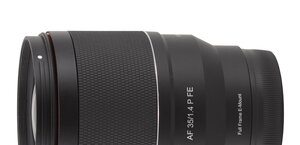Tamron 17-50 mm f/4 Di III VXD
11. Summary
Pros:
- good image quality in the frame centre across the whole focal length range,
- decent image quality on the edge of the APS-C sensor,
- negligible longitudinal chromatic aberration,
- sensible correction of coma,
- silent, quick, and accurate autofocus,
- moderate vignetting on the APS-C sensor,
- proper performance against bright light,
- acceptable price/performance ratio,
- negligible focus breathing.
Cons:
- monstrous vignetting on full frame at 17 mm focal length,
- weak image quality on the edge of full frame at 50 mm,
- huge distortion at wide angles of view turning sometimes into moustache distortion,
- some problems with spherical aberration.
Firstly I think the producers should be encouraged to launch new, original constructions on the market. Tamron made such a move and took that risk – praise for them! Secondly, the tested lens performs well in the frame centre no matter what aperture you employ. The performance is slightly weaker on the edge of the APS-C sensor and much weaker on the edge of full frame but on both types of edges the emphasis was on the shorter end of the focal length range, giving up on the maximum focal length range. In this type of construction it is a good approach. Thirdly, all flaws listed by us, like high distortion or huge vignetting, aren't felt so keenly because the producers provided almost 8 degrees of field to spare on the wide angle. After the correction both levels of distortion and vignetting aren't so high anymore.Fourthly, in order to criticize a lens you have to have a reference point and, as it happens, currently the Tamron doesn't have a direct rival. Fifthly, with such an original construction, the Tamron priced its device quite moderately – the tested lens can be bought for around $700.
As a result you get a very universal instrument, and a very interesting option for these photographers who still use cameras with two detector sizes. The Tamron 17-50 mm f/4 Di III VXD is a very well-put-together universal zoom designed for cameras with APS-C sensors but it will perform sensibly well on full frame and can be used as, e.g., an ultra wide angle device for landscape photography. There won't be any problems with stopping it down to apertures in proximity of f/8.0.
Please Support UsIf you enjoy our reviews and articles, and you want us to continue our work please, support our website by donating through PayPal. The funds are going to be used for paying our editorial team, renting servers, and equipping our testing studio; only that way we will be able to continue providing you interesting content for free. |
- - - - - - - - - - - - - - - - - - - - - - - - - - - - - - - - - - - - - - - - - - - - - - - -
Still, I trust that, like in case of many other Tamron models, the producers are already working on the G2 version of this one because here there is a really huge margin for improvement.






